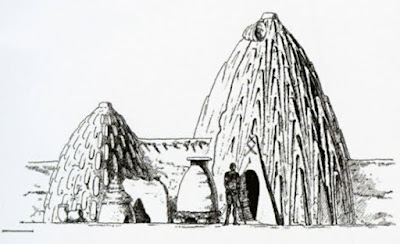Mostramos aqui uma interessante reportagem da designboom sobre as Arquitecturasdeterra da tribo Musgum, a principal étnia do Norte dos Camarões.
"designboom has dedicated a large amount of time to learn more about clay - one of the earliest natural building materials in history of men. our intent is to promote earth also as a building material of the future.it represents an excellent alternative to cement whose manufacture releases considerable quantities of CO2.individual housing units and small apartment buildings can easily be built from earth in every part of the world. however, concrete remains an essential material for high-rise construction. the research effort should betherefore two-pronged: tailoring earth to the needs of modern construction and making concrete 'greener'.in this first article of a series, which we will publish in the upcoming weeks, we'll examine a few ancient building techniques.the musgum, an ethnic group in far north province in cameroon, created their homes from compressedsun-dried mud. the tall conical dwellings, in the shape of a shell (artillery), featured geometric raised patterns.
what strikes at first sight is their almost organic simplicity, a second reading reveals the functions behind the forms. the walls of the houses are thicker at the base than at the summit, which increases the stability of the building.
a characteristic settlement form is the compound, a cluster of units linked by walls
the domed huts of the musgum people are built in shaped mud, a variant of cob. cob building is the most widely used technique in the world, since no tools are needed - hands, earth and water are enough.
the name of these houses ('cases obos') comes from their similarity with the profile of shells. it is very close to the catenary arch, the ideal mathematical form to bear a maximum weight with minimal material. this profile also reduces the pressure effect of the impact of water drops on the walls. furthermore, the extraordinary height (up to 9 meters) of these houses provides a comfort climate during hot days. the top of the house is pierced with a circular opening, allowing the air to circulate, resulting in the sensation of freshness.today, these buildings have become somewhat obsolete, with only a few groups still practicing this 'cases obos' type of construction.

it is customary to lay the mud spirally in lifts of approximately half a metre, allowing each lift to dry before adding the next.

it is customary to lay the mud spirally in lifts of approximately half a metre, allowing each lift to dry before adding the next.
the decorative surface allows for further refinement and individualization.the veins are also contributing to the drainage of rain. the musgum houses require regular maintenance of the coating and the veins allow people to climb atop the building.
The construction technique of musgum clay houses is currently also mentioned in theexhibition 'ma terre premiere pour construire demain'. it explores how and why we should build with earth.on show at the cité des science et de l'industrie, paris until june 10th, 2010."
Autoria: andrea db 02.18.10
Fonte da notícia: aqui






























![Terra [In]cognita project: Earthen architecture in Europe](https://blogger.googleusercontent.com/img/b/R29vZ2xl/AVvXsEjIS5lNr8tO_b1BIAUxQ7yOk-fWtBc-FOHi46AK7z5ExhggwlbKr1PYY6WxDega-Jey3Gc5tVPqpfmw8v-uiG8VWsXYWoBV7mPNsTfnEZ9HICEYXZwTmBQT1fbxZ0D0nR5b153SjGCFhk4/s285/logoterraincognita.jpg)

Sem comentários:
Enviar um comentário